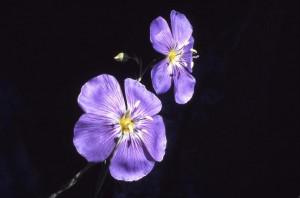
Flax plant
The term “linen” is often used to describe textiles such as bedding, table cloths, towels, etc. But originally, “linen” refers to a fabric made from flax fibers. On the other, linen clothes could be made from textiles in a linen-weave texture such as cotton, hemp, or they could be synthetic. The true linen clothes, however, are made from flax. Organic linen is made from plant fibers as opposed to synthetic means. The plants should have been grown without the use of toxic pesticides, herbicides and fertilizers.
From flax to linen
For 10 000 years flax (Linum usitatissimum = “most useful linen”) is a source of textiles with special properties: soft hand, rich color absorption, lasting durability, and exceptional comfort. Being cultivated annually, flax plants like temperate climates, especially of Northern Europe. The plant grows to about 1 meter in height in 3-4 months. By the end of June, flax fields are covered with blossoms of violet, blue and white. But this picturesque scenery is over quickly for each flax plant blooms for one day only.
After flowering, the whole plant is pulled to obtain the maximum length of fiber. Then, the flax stems are tied into bundles and hung out to dry. Once dried, the stems are “combed” to remove the seed pods. The stems are then retted – a process which uses bacteria to decompose the pectin that binds the fibers together. There are chemical retting methods, which are faster, but more harmful to the environment and to the fibers themselves. So, if linen clothes should be organic, the retting is to be done without the use of chemicals.
Then the woody parts of the stalks are removed and the fibers that have left are “combed”, till the long and soft flax fibers are separated. After they have been processed, they are spun into yarns and woven or knit into linen textiles. These textiles can then be bleached, dyed, printed or finished with a number of treatments or coatings.
Is flax eco-friendly?
Well, probably not as much as hemp is. Flax needs very few chemicals and few or no fertilizers, and pesticides are being used compared to other crops, e.g. cotton.
Flax does not require irrigation during the growing process. The plant is gentle to the land and is easy to incorporate into crop rotation cycles.
All parts of the plant are used without any waste and are biodegradable or recyclable.
Flax seeds are used in human and animal nutrition due to its very high content of alpha omega-3 fatty acids.
Oil squeezed out of flax seeds is used as a component in paints, cosmetics, soil coverings, etc.
Flax fibers are also used in heat insulation and packaging. The remaining residual products are used in fiber boards, bank notes, etc.
Linen clothes & their properties
Linen clothes are soft and comfortable. They breathe, much like human skin. They absorb up to 20% of its weight in moisture before they feel wet, and easily release moisture to remain cool and dry to the skin. They are great to wear in hot weather.
Linen clothes have a soft hand and get softer the more they are washed. However, they have little elasticity and do not spring back readily, which explains the wrinkles. The latter are considered by some as part of the fabric’s particular “charm” – a sign of naturalness and luxury. Due to this lack of elasticity, the fabric will eventually break if it is folded and ironed at the same place repeatedly. Linen clothes are much easier to iron when damp.

